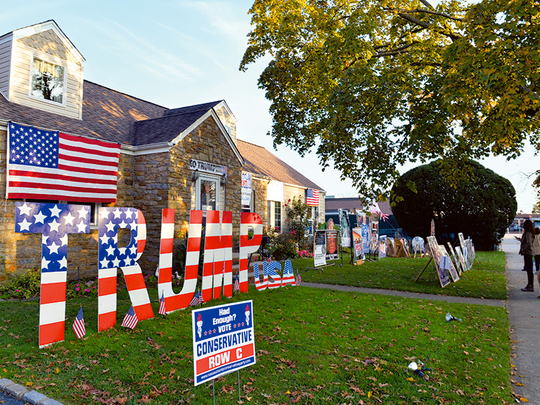
Dubai: Even if no one else does, the US advertising industry will miss the noise and bluster of the presidential elections — ad spend is expected to take a 1.5 per cent decline in 2017, according to early estimates.
The dip will be led by lower exposures to television commercial spots — the largest media platform in the US — by as much as 4.5 per cent, according to estimates from the marketing research firm Warc. There will be ramnifications for the rest of the world as well — “A slowdown in the US will have an impact on global growth; we estimate that global advertising spend grew 5.2 per cent in 2016, but expect the rate of expansion to slow to 3.6 per cent next year,” said James McDonald, Warc’s senior data analyst.
Donald Trump and Hillary Clinton blitzed just about every advertising platform with their messages in the lead up to the November 8 elections. The various mini-contests for the US Senate and Congress also added up to a nice little pile for the advertising industry to catch in.
Worldwide, in 2015, TV was “still” the largest ad medium by spend — at $195 billion (Dh715.95 billion) — “though a strong dollar removed $17.8 billion from global TV ad revenues”, according to the Warc ‘Global Ad Trends’ report. As such, “TV’s share of global ad spend has fallen each year between 2012 and 2015, with the 1.6 percentage point loss in 2015 representing the largest decline on record.”
As far as global ad spend growth rates are concerned, the Rio Olympics kept up the pace during the summer months. And advertisers and brands will have to wait awhile for such year-defining political and sporting extravaganzas.
“Of our 12 key markets, which between them account for over two-thirds of all the ad spend monitored by Warc, China [a projected growth of 9.5 per cent] and India [up by 9.2 per cent] are expected to be the fastest-growing next year,” said McDonald.
As for this part of the world, Warc estimates place ad bookings (based on official media tariff rates) to be valued at $14 billion in 2015. But the region has gone through an exceptionally tough year — estimates range between 10 and 20 per cent in terms of ad spend drop — and prospects for a full-fledged recovery in 2017 are, as of now, looking extremely remote.
The Middle East will not be alone in seeing ads drop; apart from the US, seven markets that Warc deemed as being key drivers of spending, are likely to see a slowdown in growth next year.
But there is no stopping the march of mobile ad spends, as advertisers re-learn the ways and means to get into the personal space of consumers. In China, mobile is likely to close the year as the “largest ad platform” — the first time it would be happening in any market. And in the US, mobile-driven ads could become the second largest — after TV — next year, “with some $40 billion expected to be spent reaching consumers on their phones,” Warc estimates.
In the UK, one in four pounds spent on advertising today goes to search providers such as Google.
The worldwide internet-based ad spend is expected to rise 12.5 per cent in 2017 compared to a 1.9 per cent decline for TV. (For comparison’s sake, online advertising generated around $155 billion in 2015. And of this, 30.7 per cent went on mobile ads as against the 1 per cent in 2006.
According to McDonald, “The combined value of ad trade worldwide took a full eight years to recover from the global financial crisis. It is also fascinating to note the juxtaposed trajectories of the world’s two largest advertising markets.
“While the amount spent to secure ad space in the US remained unchanged during the 10 years to 2015, that spent in China grew three-and-a-half times over this period.”











